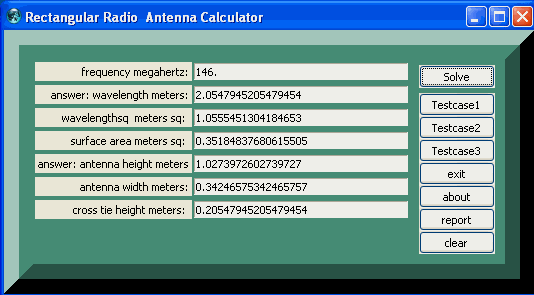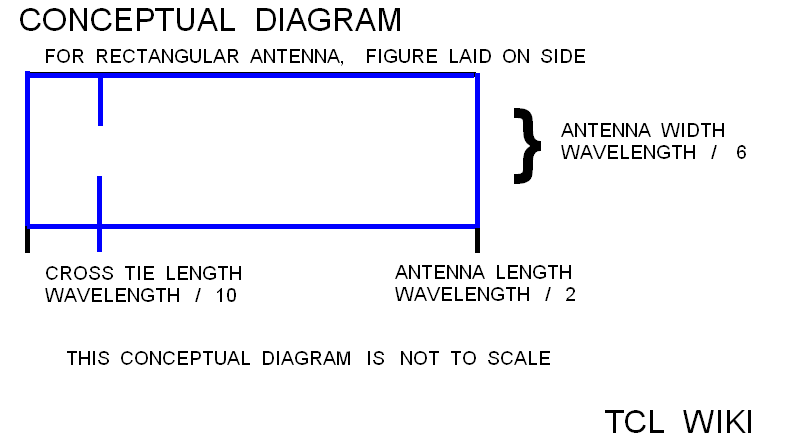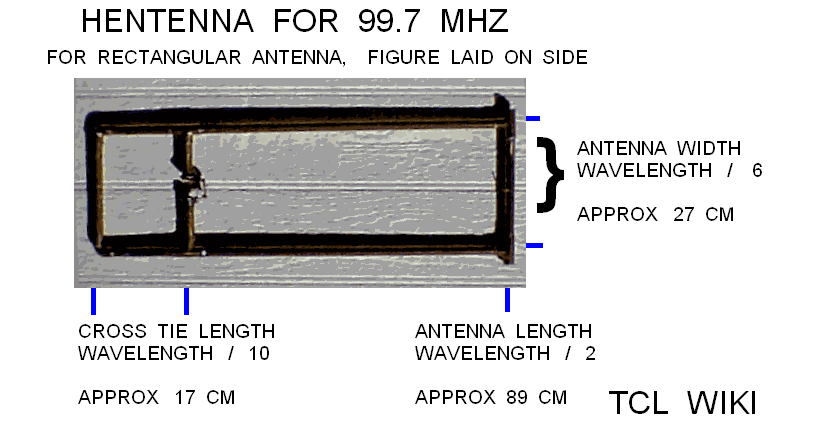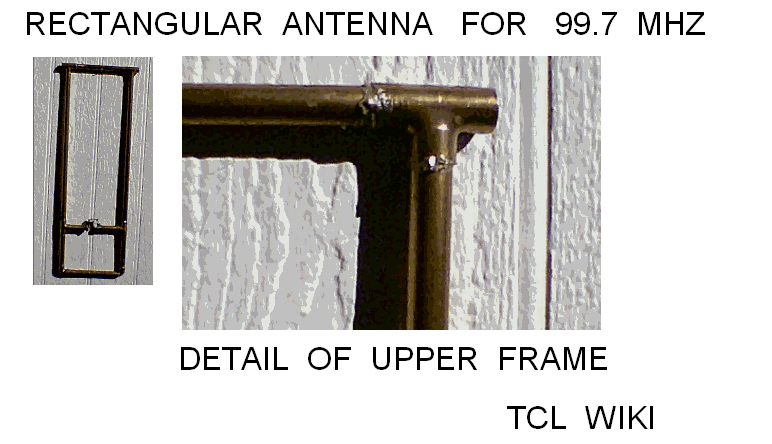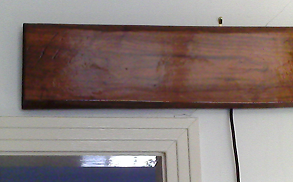Rectangular Radio Antenna and etcl Slot Calculator Demo Example
Rectangular Radio Antenna and eTCL Slot Calculator Demo Example
This page is under development. Comments are welcome, but please load any comments in the comments section at the bottom of the page. Please include your wiki MONIKER and date in your comment with the same courtesy that I will give you. Aside from your courtesy, your wiki MONIKER and date as a signature and minimal good faith of any internet post are the rules of this TCL-WIKI. Its very hard to reply reasonably without some background of the correspondent on his WIKI bio page. Thanks, gold 12DEC2018
- Rectangular Radio Antenna and eTCL Slot Calculator Demo Example
- Introduction
- Appendix Code
- Comments Section
Introduction
gold Here is some eTCL starter code for calculating rectangular antennas from source frequency and other dimensions. The impetus for these calculations was designing rectangular antennas. Most of the testcases involve modeled data, using assumptions and rules of thumb .
The hentenna is a rectangular radio antenna with a cross bar tie for antenna leads. The original hentenna was designed in Japan for short wave frequencies on the order of 20 to 50 megahertz. "Hen" means strange in Japanese. The early hentennas were vertical and usually backed up to the east or west side of a house for radio reception in the temperate zone, given the horizontal space saving imperative in Japan. Given a design frequency in megahertz, the various dimensions and proportions of the radio antenna are cut at height of wavelength(1/2), width of wavelength(1/6), and cross tie of wavelength(1/10). For simplified calculations, the radio wavelength in meters is equal to the speed_of_light in kilometers per second (300) over the radio frequency in megahertz. For an example of a receiving antenna for 100 megahertz and rounded numbers, the expressions below can be pasted into the eTCL console:
A rectangular radio antenna or hentenna designed for 99.7 mhz was built from half inch copper pipe. The antenna had sufficiently narrow beamwidth to distinguish between two FM broadcast transmitters about 10 degrees azimuth apart. The hentenna has a horizontally polarized output. The horizontal output cancels out some of the urban noise environment, since many broadcast signals are vertically polarized.
Alternate Wordy Text
The Hentenna is a rectangular radio antenna with a cross bar tie for antenna leads. The original Hentenna was designed in Japan for short wave frequencies on the order of 20 to 50 megahertz. "Hen" means strange in Japanese. The early Hentennas were vertical and usually backed up to the east or west side of a house for SW radio reception in the temperate zone, given the horizontal space saving imperative in Japan. Given a design frequency in megahertz, the various dimensions and proportions of the radio antenna are cut at height of wavelength(1/2), width of wavelength(1/6), and cross tie of wavelength(1/10). For simplified calculations, the radio wavelength in meters is equal to the speed_of_light in kilometers per second (300) over the radio frequency in megahertz.
A rectangular radio antenna or Hentenna designed for 99.7 mhz was built from half inch copper pipe. The antenna had sufficiently narrow beamwidth to distinguish between two FM broadcast transmitters about 10 degrees azimuth apart. For testing, a small crystal set on a PC card was placed between the cross bar taps or gap left between cross bar. Very little AM power from test antenna was received on crystal set, but Hentenna would have to be full size, 5 meters Vertical.
The Hentenna was dubbed in Japan and has a reputation for DX in the SW band. The Hentenna has a >>>Horizontal Polarization<<< output, meaning at the cross bar taps. The horizontal output cancels out some of the urban noise environment, since many broadcast signals are vertically polarized. The Hentenna beam pattern in the SW band has a horizontal peanut shape extending from 15 to 18 degrees above the local ground horizon. Antenna gain is about 2.5-3 dBd. In some SW geometries for over-the-horizon broadcasts, the SW signals arrive in somewhat matching angles 10 to 20 degrees across the ocean. Possibly, some of the strange anomalous reception of weak SW signals was a combination of 1) the peanut shaped antenna pattern, 2) the approximate 15 to 20 beamwidth, and 3) the polarization feature of the Hentenna. As experiments with the smaller Hentenna versions, natch, it is also possible to lay or design the Hentenna on the side to receive >> Vertical Polarization << at the taps. Continuing the experiments, the smaller rectangular antennas can be backed with a metal or foil for higher gain, ~~ 6 dBd . As a concept or thought experiment, it would seem possible that alternate taps apart from the cross bar might allow different polarized components of an SW signal.
Crafting Notes. The copper pipe is used to increase effective conductor width or Antenna bandwidth for FM reception. In an alternate rectangular version for 500 Mhz, the copper wire antenna is tacked to a varnished "pretty" wood board for cosmetics, if not in a college dorm or attic.
There are current patents for rectangular antennas the size of credit cards and meant to be printed in gold on the PC boards of cell phones , but the patents do not mention the term "Hentenna".
namespace path {::tcl::mathop ::tcl::mathfunc}
set megafrequency 100.
set wavelength [/ 300. $megafrequency ]
set wavelength2 [/ $wavelength 2.]
set wavelength6 [/ $wavelength 6.]
set wavelength10 [/ $wavelength 10.]
Testcases Section
In planning any software, it is advisable to gather a number of testcases to check the results of the program. The math for the testcases can be checked by pasting statements in the TCL console. Aside from the TCL calculator display, when one presses the report button on the calculator, one will have console show access to the capacity functions (subroutines).
Testcase 1
| quantity | calc output | hand solution | comment |
|---|---|---|---|
| frequency megahertz | 500. | 500. | input |
| antenna height meters | .3 | .91 | output |
| antenna width meters | .1 | .28 | output |
| tie bar height | .06 | .21 | output |
Testcase 2
| quantity | calc output | hand solution | comment |
|---|---|---|---|
| frequency megahertz | 144. | 144. | input |
| antenna height meters | .34 | .314 | output |
| antenna width meters | 1.04 | .824 | output |
| tie bar height | .208 | .219 | output |
Testcase 3
| quantity | calc output | hand solution | comment |
|---|---|---|---|
| frequency megahertz | 99.7 | 100. | input |
| antenna height meters | 1.5 | .31 | output |
| antenna width meters | .5 | .11 | output |
| tie bar height | .3 | .6 | output |
Testcase 4
| quantity | calc output | hand solution | comment |
|---|---|---|---|
| frequency megahertz | 150 | 150 | input |
| antenna height meters | 1. | .9 | output |
| antenna width meters | .3 | .31 | output |
| tie bar height | .2 | .25 | output |
Testcase 5
| quantity | calc output | hand solution | comment |
|---|---|---|---|
| frequency megahertz | 50. | 50. | input |
| antenna height meters | 3. | 3.1 | output |
| antenna width meters | 1. | .9 | output |
| tie bar height | .6 | .61 | output |
Screenshots Section
figure 1.
figure 2.
figure 3.
figure 4.
figure 5.
figure 6., New Hidden Antenna in Kitchen
References:
- Antennas, Balanis
Appendix Code
appendix TCL programs and scripts
# TCL source code follows
# pretty print from autoindent and ased editor
# Rectangular Radio Antenna calculator V2
# written on Windows XP on TCL
# working under TCL version 8.6
# gold on TCL Club, 12Dec2018
package require Tk
package require math::numtheory
namespace path {::tcl::mathop ::tcl::mathfunc math::numtheory }
set tcl_precision 17
frame .frame -relief flat -bg aquamarine4
pack .frame -side top -fill y -anchor center
set names {{} {frequency megahertz:} }
lappend names {answers: wavelength meters:}
lappend names {wavelengthsq meters sq: }
lappend names {surface area meters sq: }
lappend names {antenna height meters:}
lappend names {antenna width meters: }
lappend names {cross tie height meters: }
lappend names {corrected height above ground meters:: }
foreach i {1 2 3 4 5 6 7 8} {
label .frame.label$i -text [lindex $names $i] -anchor e
entry .frame.entry$i -width 35 -textvariable side$i
grid .frame.label$i .frame.entry$i -sticky ew -pady 2 -padx 1 }
proc about {} {
set msg "Calculator for Rectangular Radio Antenna
from TCL
# gold on TCL Club, 12Dec2018 "
tk_messageBox -title "About" -message $msg }
proc self_help {} {
set msg " Rectangular Radio Antenna V2
from TCL ,
# self help listing
# problem, Rectangular Radio Antenna V2
# 1 given follows.
1) frequency megahertz:
# Recommended procedure is push testcase and fill frame,
# change first three entries etc, push solve,
# and then push report. Report allows copy and paste
# from console to conventional texteditor. For testcases
# testcase number is internal to the calculator and
# will not be printed until the report button is pushed
# for the current result numbers.
# >>> copyright notice <<<
# This posting, screenshots, and TCL source code is
# copyrighted under the TCL/TK license terms.
# Editorial rights and disclaimers
# retained under the TCL/TK license terms
# and will be defended as necessary in court.
Conventional text editor formulas or grabbed from internet
screens can be pasted into green console.
# gold on TCL Club, 12Dec2018 "
tk_messageBox -title "Self_Help" -message $msg }
proc calculate { } {
global answer2
global side1 side2 side3 side4 side5
global side6 side7 side8
global testcase_number
global wavelength wavelength2
global wavelength6 wavelength10
global wavelengthsq surfacearea
global megafrequency
incr testcase_number
set side1 [* $side1 1. ]
set side2 [* $side2 1. ]
set side3 [* $side3 1. ]
set side4 [* $side4 1. ]
set side5 [* $side5 1. ]
set side6 [* $side6 1. ]
set side7 [* $side7 1. ]
set side8 [* $side8 1. ]
global wavelength wavelength2
global wavelength6 wavelength10
global wavelengthsq surfacearea
global megafrequency
incr testcase_number
set megafrequency $side1
set wavelength [/ 300. $megafrequency ]
set wavelength2 [/ $wavelength 2.]
set wavelength6 [/ $wavelength 6.]
set wavelength10 [/ $wavelength 10.]
set wavelengthsq [* $wavelength2 $wavelength2 ]
set surfacearea [* $wavelength2 $wavelength6 ]
set corrected_height_above_ground [* $wavelength 2.]
set side2 $wavelength
set side3 $wavelengthsq
set side4 $surfacearea
set side5 $wavelength2
set side6 $wavelength6
set side7 $wavelength10
set side8 $corrected_height_above_ground
}
proc fillup {aa bb cc dd ee ff gg hh} {
.frame.entry1 insert 0 "$aa"
.frame.entry2 insert 0 "$bb"
.frame.entry3 insert 0 "$cc"
.frame.entry4 insert 0 "$dd"
.frame.entry5 insert 0 "$ee"
.frame.entry6 insert 0 "$ff"
.frame.entry7 insert 0 "$gg"
.frame.entry8 insert 0 "$hh"
}
proc clearx {} {
foreach i {1 2 3 4 5 6 7 8 } {
.frame.entry$i delete 0 end } }
proc reportx {} {
global answer2
global side1 side2 side3 side4 side5
global side6 side7 side8
global testcase_number
global wavelength wavelength2
global wavelength6 wavelength10
global wavelengthsq surfacearea
global megafrequency
console eval {.console config -bg palegreen}
console eval {.console config -font {fixed 20 bold}}
console eval {wm geometry . 40x20}
console eval {wm title . " Rectangular Radio Antenna Report V2, screen grab and paste from console 2 to texteditor"}
console eval {. configure -background orange -highlightcolor brown -relief raised -border 30}
console show;
puts "%|table $testcase_number |printed in| tcl format|% "
puts "&| quantity| value| comment, if any|& "
puts "&| $testcase_number :|testcase_number | |&"
puts "&| $side1 :|frequency megahertz: | |&"
puts "&| $side2 :|answers: wavelength meters: | |& "
puts "&| $side3 :|wavelengthsq meters sq: | |& "
puts "&| $side4 :|surface area meters sq: | |&"
puts "&| $side5 :|antenna height meters: | |&"
puts "&| $side6 :|antenna width meters: | |&"
puts "&| $side7 :|cross tie height meters: | |&"
puts "&| $side8 :|corrected height above ground meters: | |&"
}
frame .buttons -bg aquamarine4
::ttk::button .calculator -text "Solve" -command { set side8 0 ; calculate }
::ttk::button .test2 -text "Testcase1" -command {clearx;fillup 146. 2. 1. .35 1.0981 .34 .205 4.1 }
::ttk::button .test3 -text "Testcase2" -command {clearx;fillup 99.7 3.2 2.2 .75 1.5 .5 .3 6.0 }
::ttk::button .test4 -text "Testcase3" -command {clearx;fillup 500. .6 .09 .03 .28 .1 .06 1.2 }
::ttk::button .clearallx -text clear -command {clearx }
::ttk::button .about -text about -command {about}
::ttk::button .self_help -text self_help -command { self_help }
::ttk::button .cons -text report -command { reportx }
::ttk::button .exit -text exit -command {exit}
pack .calculator -in .buttons -side top -padx 10 -pady 5
pack .clearallx .cons .self_help .about .exit .test4 .test3 .test2 -side bottom -in .buttons
grid .frame .buttons -sticky ns -pady {0 10}
. configure -background aquamarine4 -highlightcolor brown -relief raised -border 30
wm title . "Rectangular Radio Antenna Calculator V2" Pushbutton Operation
For the push buttons, the recommended procedure is push testcase and fill frame, change first three entries etc, push solve, and then push report. Report allows copy and paste from console.
For testcases in a computer session, the eTCL calculator increments a new testcase number internally, eg. TC(1), TC(2) , TC(3) , TC(N). The testcase number is internal to the calculator and will not be printed until the report button is pushed for the current result numbers (which numbers will be cleared on the next solve button.) The command { calculate; reportx } or { calculate ; reportx; clearx } can be added or changed to report automatically. Another wrinkle would be to print out the current text, delimiters, and numbers in a TCL wiki style table as
puts " %| testcase $testcase_number | value| units |comment |%" puts " &| volume| $volume| cubic meters |based on length $side1 and width $side2 |&"
Initial Console Program
# pretty print from autoindent and ased editor
# written on Windows XP on eTCL
# working under TCL version 8.6.2 and_or eTCL 1.0.1
# gold on TCL WIKI, 15oct2014
#Console program for rectangular antenna (hentenna in Japan)
package require Tk
namespace path {::tcl::mathop ::tcl::mathfunc}
console show
proc antenna {args} {
foreach item $args {
set megafrequency $item
set wavelength [/ 300. $megafrequency ]
set wavelength2 [/ $wavelength 2.]
set wavelength6 [/ $wavelength 6.]
set wavelength10 [/ $wavelength 10.]
puts " design fc mhz $megafrequency wavelength $wavelength \
ant. height $wavelength2 ant. width $wavelength6 ant. tie_bar \
height $wavelength10 \n "}}
antenna 50. 99.7 144. 150. 500.
# output
# design fc mhz 50. wavelength 6.0 ant. height 3.0 ant. width 1.0 ant. tie_bar height 0.6
# design fc mhz 99.7 wavelength 3.009 ant. height 1.504 ant. width 0.501 ant. tie_bar height 0.300
# design fc mhz 144. wavelength 2.083 ant. height 1.041 ant. width 0.347 ant. tie_bar height 0.208
# design fc mhz 150. wavelength 2.0 ant. height 1.0 ant. width 0.333 ant. tie_bar height 0.2
# design fc mhz 500. wavelength 0.6 ant. height 0.3 ant. width 0.099 ant. tie_bar height 0.06
Comments Section
Please place any comments with the courtesy of your wiki MONIKER and date here, Thanks, gold 12DEC2018
gold 9/27/2021. Switched some comment signs ;# to #. This a big file. Check earlier editions, if not compatible. Maybe obvious, but this page was written on Windows10 Tcl ports including ActiveTCL. I assume that the reader can cut and paste on screen, what the reader needs, and tootle on to his own project and own contribution pages to the TCL Wiki.
| Category Numerical Analysis | Category Toys | Category Calculator | Category Mathematics | Category Example | Toys and Games | Category Games | Category Application | Category GUI |
